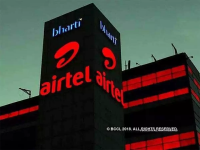Elon Musk's SpaceX urges India to allow satellite tech for rural internet; wants E&V bands: Report
Elon Musk’s aerospace company SpaceX has urged the Indian government to give approvals for providing satellite-based internet services in remote areas of India and suggested that E- and V-bands be opened up for satellite providers, as per a report by Medianama.
By ET Telecom
November 17, 2020, 18:07 IST
NEW DELHI: Elon Musk’s aerospace company SpaceX has urged the Indian government to give approvals for providing satellite-based internet services in remote areas of India and suggested that E & V bands be opened up for satellite providers, as per a report by Medianama.
The development comes close on the heels of a new draft Spacecom policy floated by the Indian Space Research Organization (ISRO) that will enable private Indian firms to use existing space assets for providing communication services as well as for developing new systems, launch satellites, and sell services to foreign customers.
SpaceX said that there need to be tech-neutral broadband definitions, spectrum allotments for satellite systems, promoting of spectrum sharing, and a review of fees and related taxes that disincentivize broadband adoption in India.
It further said that the E & V bands should be kept open for satellite providers which is in-line with TRAI’s recommendations that the E & V bands, that are typically said to be useful for 5G networks but are only used in the short distance, should be utilized for broadband deployment in India.
The California-based company is also batting for a “band-splitting” model that encourages efficient use of spectrum and added that private telcos be allowed to share spectrum.
The Ka-band frequency which is used for connecting ground stations to fixed satellite systems should be provided to satellite operators, said SpaceX further.
“While India has long encouraged satellite operators to deploy gateway earth station facilities within the country, this policy is thwarted by the absence of Ka-band frequency assignments that are required to communicate with those gateway earth stations. SpaceX encourages TRAI and spectrum agencies in India to develop an approval process for these assignments. This effort is fundamental to expanding high-speed broadband service in India,” the publication quoted SpaceX as saying.
SpaceX has also urged for blanket licensing to streamline site-per-site licensing requirements and to accelerate the deployment of two-way satellite broadband terminals for supporting satellite broadband services such as Starlink.
However, India’s telecom service providers have expressed concerns over the “backdoor entry” of satellite communications (Satcom) operators in the country, ETTelecom reported. They want the Department of Telecommunications to provide spectrum only through auctions and not through the administrative route.

Elon Musk's SpaceX urges India to allow satellite tech for rural internet; wants E&V bands: Report - ET Telecom | Satcom
Elon Musk’s aerospace company SpaceX has urged the Indian government to give approvals for providing satellite-based internet services in remote areas of India and suggested that E- and V-bands be opened up for satellite providers, as per a report by Medianama.telecom.economictimes.indiatimes.com
Reaction:
Indian telcos flag concerns over backdoor entry of Satcom operators: Report
India’s telecom service providers have written to the Department of Space flagging their concerns over the “backdoor entry” of satellite communications (Satcom) operators in the country, as per a Business Standard report.
By ET Telecom
Updated: November 16, 2020, 15:50 IST

NEW DELHI: India’s telecom service providers have written to the Department of Space flagging their concerns over the “backdoor entry” of satellite communications (Satcom) operators in the country, as per a Business Standard report.
This follows billionaire businessman Elon Musk’s announcement on microblogging platform Twitter that his Starlink internet services would launch in India once it receives regulatory approvals in 2021.
The Cellular Operators Association of India (COAI), while responding to the draft Spacecom Policy released last month, has opined that non-government private entities (NGPE) that have been permitted to establish their own space systems for providing communication services should be objected to the same licensing regulations as telecom service providers (TSPs) in order to ensure a “level playing field.”
COAI has further demanded that NGPEs obtain spectrum through auctions, like how telcos do and not just through authorization by the Department of Telecommunications (DoT), as suggested in the draft policy.
The telcos have further warned the telecom department that a license should be made necessary as the “international satellite lobby” may establish NGPEs in order to come up with a number of paper satellite filings to claim protection from the terrestrial use of mmWave bands earmarked for IMT services.
The COAI letter further states that this “abnormal protection” may drive up costs for the deployment of next-generation network technology, consequently depriving Indians of 5G services.
"Stringent criterion and control on private satellite filings and the protection criterion must be considered after these NGPEs acquire spectrum through auction", the COAI said in its letter.
The COAI represents Airtel, Vi, and Reliance Jio and global original equipment manufacturers (OEMs) such as Nokia and Ericsson.
This latest letter was sent after an apex panel of secretaries nudged the Department of Space (DoS) and the defense ministry to heed the DoT’s request to part with unused 5G spectrum – both in the coveted 26 GHz band and those in the 3.3-3.6 GHz frequencies – for commercial use by telcos.
The DoT wants the government to release 3,000 units of 26 GHz millimeter wave spectrum and 300 units in the 3.3-3.6 GHz for 5G. The airwaves are with the DoS and the defense ministry.
Globally, satellite-based broadband services have been picking pace. Bharti Airtel has also bought a 45% stake in UK-based communications company OneWeb for $500 million. A joint bidding entity of Bharti Global and the British government, which recently won a bid to take over UK’s OneWeb, has written to Indian National Space Promotion and Authorisation Centre (IN-SPACe) to secure landing rights to use the bankrupt British firm’s satellite systems capacity in India to deliver fast wireless broadband services, ET had reported.
Bharti Global is the overseas arm of Bharti Enterprises – the holding company of Bharti Airtel, India’s second-largest telecom operator.

Indian telcos flag concerns over backdoor entry of Satcom operators: Report - ET Telecom | Satcom
Vodafone Idea: India’s telecom service providers have written to the Department of Space flagging their concerns over the “backdoor entry” of satellite communications (Satcom) operators in the country, as per a Business Standard report.











